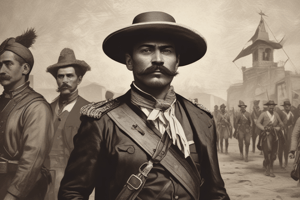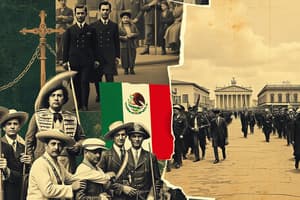Podcast
Questions and Answers
What was the primary motivation behind Emilio Vásquez Gómez's movement to overthrow Madero?
What was the primary motivation behind Emilio Vásquez Gómez's movement to overthrow Madero?
Why was the capture of Ciudad Juárez by the Vasquistas significant to Madero?
Why was the capture of Ciudad Juárez by the Vasquistas significant to Madero?
What was the main reason why the Vasquistas agreed to meet with Orozco rather than fight him?
What was the main reason why the Vasquistas agreed to meet with Orozco rather than fight him?
The Plan Orozquista was critical of Madero for violating the principles outlined in the Plan de San Luis Potosí. Which of the following was NOT cited as an example of such a violation?
The Plan Orozquista was critical of Madero for violating the principles outlined in the Plan de San Luis Potosí. Which of the following was NOT cited as an example of such a violation?
Signup and view all the answers
Who among these individuals benefitted financially from the Orozco movement?
Who among these individuals benefitted financially from the Orozco movement?
Signup and view all the answers
What was the primary reason Félix Díaz appealed to the army?
What was the primary reason Félix Díaz appealed to the army?
Signup and view all the answers
Why was the overthrow of Madero significant?
Why was the overthrow of Madero significant?
Signup and view all the answers
What was the outcome of the initial attack on the National Palace?
What was the outcome of the initial attack on the National Palace?
Signup and view all the answers
What is the significance of the 'Decena Trágica'?
What is the significance of the 'Decena Trágica'?
Signup and view all the answers
What was the result of Madero's decision to appoint Victoriano Huerta?
What was the result of Madero's decision to appoint Victoriano Huerta?
Signup and view all the answers
Which of the following statements accurately reflects the primary objective of the Plan de Ayala, as outlined in the text?
Which of the following statements accurately reflects the primary objective of the Plan de Ayala, as outlined in the text?
Signup and view all the answers
What was a significant consequence of Madero's inability to quell the Zapatista rebellion?
What was a significant consequence of Madero's inability to quell the Zapatista rebellion?
Signup and view all the answers
What is the significance of General Bernardo Reyes's failed rebellion?
What is the significance of General Bernardo Reyes's failed rebellion?
Signup and view all the answers
Which of the following factors contributed to the failure of General Bernardo Reyes's rebellion?
Which of the following factors contributed to the failure of General Bernardo Reyes's rebellion?
Signup and view all the answers
Who played a crucial role in developing and articulating the goals of the Plan de Ayala?
Who played a crucial role in developing and articulating the goals of the Plan de Ayala?
Signup and view all the answers
Study Notes
Chapter 27: Revolutions and Dictatorship Obstructing Democratic Reform
- Emiliano Zapata led a revolt against the new Mexican government in November 1911, advocating for agrarian reform through the Plan de Ayala.
- The Plan de Ayala aimed to return land, woods, and water to villages/citizens who held prior titles to them.
- The armed conflict spread rapidly, disrupting railroads and telegraphs, and forcing the government on the defensive.
- In early 1912, Zapata's forces controlled several towns and significantly hampered the government's control.
- General Bernardo Reyes led a separate revolt in the north of Mexico in December 1911, but his movement did not gain strong support.
- Emilio Vasquez Gomez launched a revolt in Chihuahua in late 1911 due to perceived electoral injustices.
- Pascual Orozco orchestrated a major revolt in the north in 1912, aided by the Terrazas clique in Chihuahua, demanding social change.
- The Plan Orozquista, a comprehensive reform plan, criticized Madero's government for corruption and nepotism.
- In February 1913, General Victoriano Huerta orchestrated a coup in Mexico City, leading to the overthrow of President Madero. Events were supported by other generals, culminating in the deaths of Madero and Pino Suárez.
- Huerta's rise to power marked the end of Madero's democratic government.
- The United States refused to recognize Huerta's regime, impacting Mexican politics and economy.
- Numerous revolts continued to challenge Huerta's rule throughout the following years, culminating in his overthrow.
Studying That Suits You
Use AI to generate personalized quizzes and flashcards to suit your learning preferences.
Related Documents
Description
Explore the significant revolts in Mexico during 1911-1912 led by Emiliano Zapata and others. This chapter focuses on the demands for agrarian reform and the impact of these revolutionary movements on the government. Dive into the complexities of the Plan de Ayala and the broader implications for democratic reform.




